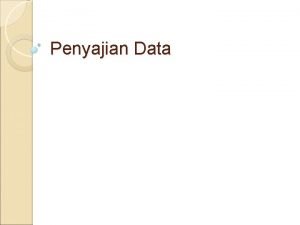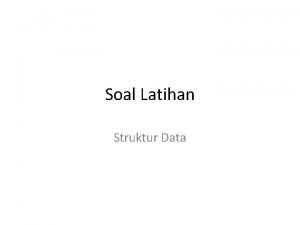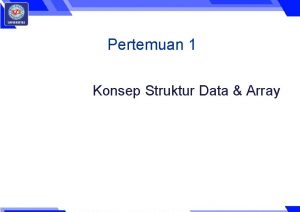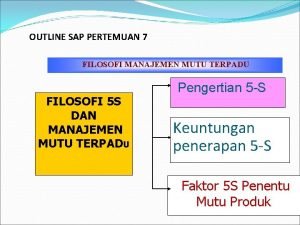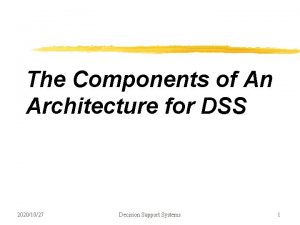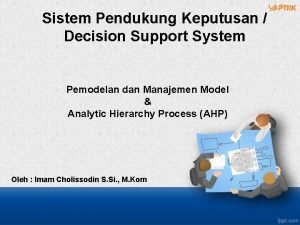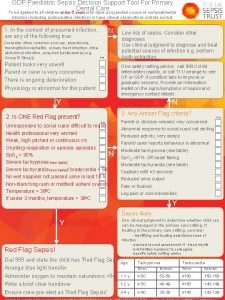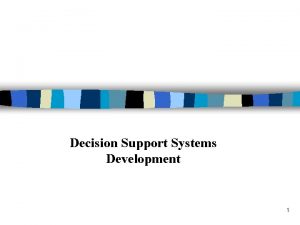Decision Support Systems and Intelligent Systems PERTEMUAN 5














































- Slides: 46

Decision Support Systems and Intelligent Systems PERTEMUAN 5 PROGRAM STUDI SISTEM INFORMASI FAKULTAS ILMU KOMPUTER

Data warehousing and OLAP 2

Acknowledgement These slides have been adapted from these online resources: n Han, Kamber, and Pei, Data mining: Concepts and Techniques (3 rd edition) http: //hanj. cs. illinois. edu/bk 3_slidesindex. htm 3

Outline n Data Warehouse: Basic Concepts n Data Warehouse Modeling: Data Cube and OLAP n Data Warehouse Design and Usage n Data Warehouse Implementation 4

What is a Data Warehouse? n Defined in many different ways, but not rigorously. n A decision support database that is maintained separately from the organization’s operational database n Support information processing by providing a solid platform of consolidated, historical data for analysis. n “A data warehouse is a subject-oriented, integrated, time-variant, and nonvolatile collection of data in support of management’s decision-making process. ”—W. H. Inmon n Data warehousing: n The process of constructing and using data warehouses 5

Data Warehouse—Subject-Oriented n Organized around major subjects, such as customer, product, sales n Focusing on the modeling and analysis of data for decision makers, not on daily operations or transaction processing n Provide a simple and concise view around particular subject issues by excluding data that are not useful in the decision support process 6

Data Warehouse—Integrated n n Constructed by integrating multiple, heterogeneous data sources n relational databases, flat files, on-line transaction records Data cleaning and data integration techniques are applied. n Ensure consistency in naming conventions, encoding structures, attribute measures, etc. among different data sources n n E. g. , Hotel price: currency, tax, breakfast covered, etc. When data is moved to the warehouse, it is converted. 7

Data Warehouse—Time Variant n The time horizon for the data warehouse is significantly longer than that of operational systems n n n Operational database: current value data Data warehouse data: provide information from a historical perspective (e. g. , past 5 -10 years) Every key structure in the data warehouse n n Contains an element of time, explicitly or implicitly But the key of operational data may or may not contain “time element” 8

Data Warehouse—Nonvolatile n A physically separate store of data transformed from the operational environment n Operational update of data does not occur in the data warehouse environment n Does not require transaction processing, recovery, and concurrency control mechanisms n Requires only two operations in data accessing: n initial loading of data and access of data 9

OLTP vs. OLAP 10

Why a Separate Data Warehouse? n High performance for both systems n n n Warehouse—tuned for OLAP: complex OLAP queries, multidimensional view, consolidation Different functions and different data: n n DBMS— tuned for OLTP: access methods, indexing, concurrency control, recovery missing data: Decision support requires historical data which operational DBs do not typically maintain data consolidation: DS requires consolidation (aggregation, summarization) of data from heterogeneous sources data quality: different sources typically use inconsistent data representations, codes and formats which have to be reconciled Note: There are more and more systems which perform OLAP analysis directly on relational databases 11

Data Warehouse: A Multi-Tiered Architecture Other sources Operational DBs Metadata Extract Transform Load Refresh Monitor & Integrator Data Warehouse OLAP Server Serve Analysis Query Reports Data mining Data Marts Data Sources Data Storage OLAP Engine Front-End Tools 12

Three Data Warehouse Models n n Enterprise warehouse n collects all of the information about subjects spanning the entire organization Data Mart n a subset of corporate-wide data that is of value to a specific groups of users. Its scope is confined to specific, selected groups, such as marketing data mart n n Independent vs. dependent (directly from warehouse) data mart Virtual warehouse n A set of views over operational databases n Only some of the possible summary views may be materialized 13

Extraction, Transformation, and Loading (ETL) n n n Data extraction n get data from multiple, heterogeneous, and external sources Data cleaning n detect errors in the data and rectify them when possible Data transformation n convert data from legacy or host format to warehouse format Load n sort, summarize, consolidate, compute views, check integrity, and build indicies and partitions Refresh n propagate the updates from the data sources to the warehouse 14

Metadata Repository n Meta data is the data defining warehouse objects. It stores: n Description of the structure of the data warehouse n n schema, view, dimensions, hierarchies, derived data defn, data mart locations and contents Operational meta-data n data lineage (history of migrated data and transformation path), currency of data (active, archived, or purged), monitoring information (warehouse usage statistics, error reports, audit trails) n The algorithms used for summarization n The mapping from operational environment to the data warehouse n n Data related to system performance n warehouse schema, view and derived data definitions Business data n business terms and definitions, ownership of data, charging policies 15

Data Warehousing and On-line Analytical Processing n Data Warehouse: Basic Concepts n Data Warehouse Modeling: Data Cube and OLAP n Data Warehouse Design and Usage n Data Warehouse Implementation 16

From Tables and Spreadsheets to Data Cubes n A data warehouse is based on a multidimensional data model which views data in the form of a data cube n A data cube, such as sales, allows data to be modeled and viewed in multiple dimensions n Dimension tables, such as item (item_name, brand, type), or time(day, week, month, quarter, year) n Fact table contains measures (such as dollars_sold) and keys to each of the related dimension tables n In data warehousing literature, an n-D base cube is called a base cuboid. The top most 0 -D cuboid, which holds the highest-level of summarization, is called the apex cuboid. The lattice of cuboids forms a data cube. 17

Cube: A Lattice of Cuboids all time 0 -D (apex) cuboid item time, location time, item location item, location time, supplier location, supplier item, supplier time, location, supplier time, item, location time, item, supplier 1 -D cuboids 2 -D cuboids 3 -D cuboids item, location, supplier 4 -D (base) cuboid time, item, location, supplier 18

Conceptual Modeling of Data Warehouses n Modeling data warehouses: dimensions & measures n Star schema: A fact table in the middle connected to a set of dimension tables n Snowflake schema: A refinement of star schema where some dimensional hierarchy is normalized into a set of smaller dimension tables, forming a shape similar to snowflake n Fact constellations: Multiple fact tables share dimension tables, viewed as a collection of stars, therefore called galaxy schema or fact constellation 19

Example of Star Schema time item time_key day_of_the_week month quarter year Sales Fact Table time_key item_key branch_key branch_name branch_type location_key units_sold dollars_sold avg_sales item_key item_name brand type supplier_type location_key street city state_or_province country Measures 20

Example of Snowflake Schema time_key day_of_the_week month quarter year item Sales Fact Table time_key item_key branch location_key branch_name branch_type units_sold dollars_sold avg_sales Measures item_key item_name brand type supplier_key supplier_type location_key street city_key city state_or_province country 21

Example of Fact Constellation time_key day_of_the_week month quarter year item Sales Fact Table time_key item_key item_name brand type supplier_type location_key branch_name branch_type units_sold dollars_sold avg_sales Measures time_key item_key shipper_key from_location branch_key branch Shipping Fact Table location to_location_key street city province_or_state country dollars_cost units_shipped shipper_key shipper_name location_key shipper_type 22

A Concept Hierarchy: Dimension (location) all Europe region country city office Germany Frankfurt . . Spain North_America Canada Vancouver. . . L. Chan . . . Mexico Toronto M. Wind 23

Data Cube Measures: Three Categories n Distributive: if the result derived by applying the function to n aggregate values is the same as that derived by applying the function on all the data without partitioning n n Algebraic: if it can be computed by an algebraic function with M arguments (where M is a bounded integer), each of which is obtained by applying a distributive aggregate function n n E. g. , count(), sum(), min(), max() E. g. , avg(), min_N(), standard_deviation() Holistic: if there is no constant bound on the storage size needed to describe a subaggregate. n E. g. , median(), mode(), rank() 24

View of Warehouses and Hierarchies Specification of hierarchies n Schema hierarchy day < {month < quarter; week} < year n Set_grouping hierarchy {1. . 10} < inexpensive 25

Multidimensional Data Sales volume as a function of product, month, and region gi on Dimensions: Product, Location, Time Hierarchical summarization paths Re Industry Region Year Category Country Quarter Product n Product City Office Month Week Day Month 26

Pr od TV PC VCR sum 1 Qtr 2 Qtr Date 3 Qtr 4 Qtr sum Total annual sales of TVs in U. S. A Canada Mexico Country uc t A Sample Data Cube sum 27

Cuboids Corresponding to the Cube all 0 -D (apex) cuboid product, date country product, country 1 -D cuboids date, country 2 -D cuboids product, date, country 3 -D (base) cuboid 28

Typical OLAP Operations n Roll up (drill-up): summarize data n by climbing up hierarchy or by dimension reduction n Drill down (roll down): reverse of roll-up n from higher level summary to lower level summary or detailed data, or introducing new dimensions Slice and dice: project and select n Pivot (rotate): n n n reorient the cube, visualization, 3 D to series of 2 D planes Other operations n n drill across: involving (across) more than one fact table drill through: through the bottom level of the cube to its back-end relational tables (using SQL) 29

Fig. 3. 10 Typical OLAP Operations 30

A Star-Net Query Model Customer Orders Shipping Method Customer CONTRACTS AIR-EXPRESS ORDER TRUCK Time PRODUCT LINE ANNUALY QTRLY DAILY CITY Product PRODUCT ITEM PRODUCT GROUP SALES PERSON COUNTRY DISTRICT REGION Location Each circle is called a footprint DIVISION Promotion Organization 31

Browsing a Data Cube n n n Visualization OLAP capabilities Interactive manipulation 32

Data Warehousing and On-line Analytical Processing n Data Warehouse: Basic Concepts n Data Warehouse Modeling: Data Cube and OLAP n Data Warehouse Design and Usage n Data Warehouse Implementation 33

Design of Data Warehouse: A Business Analysis Framework n Four views regarding the design of a data warehouse n Top-down view n n Data source view n n exposes the information being captured, stored, and managed by operational systems Data warehouse view n n allows selection of the relevant information necessary for the data warehouse consists of fact tables and dimension tables Business query view n sees the perspectives of data in the warehouse from the view of end-user 34

Data Warehouse Design Process n n Top-down, bottom-up approaches or a combination of both n Top-down: Starts with overall design and planning (mature) n Bottom-up: Starts with experiments and prototypes (rapid) From software engineering point of view n n n Waterfall: structured and systematic analysis at each step before proceeding to the next Spiral: rapid generation of increasingly functional systems, short turn around time, quick turn around Typical data warehouse design process n Choose a business process to model, e. g. , orders, invoices, etc. n Choose the grain (atomic level of data) of the business process n Choose the dimensions that will apply to each fact table record n Choose the measure that will populate each fact table record 35

Data Warehouse Development: A Recommended Approach Multi-Tier Data Warehouse Distributed Data Marts Data Mart Model refinement Enterprise Data Warehouse Model refinement Define a high-level corporate data model 36

Data Warehouse Usage n Three kinds of data warehouse applications n Information processing n n n supports querying, basic statistical analysis, and reporting using crosstabs, tables, charts and graphs Analytical processing n multidimensional analysis of data warehouse data n supports basic OLAP operations, slice-dice, drilling, pivoting Data mining n n knowledge discovery from hidden patterns supports associations, constructing analytical models, performing classification and prediction, and presenting the mining results using visualization tools 37

From On-Line Analytical Processing (OLAP) to On Line Analytical Mining (OLAM) n Why online analytical mining? n High quality of data in data warehouses n DW contains integrated, consistent, cleaned data n Available information processing structure surrounding data warehouses n ODBC, OLEDB, Web accessing, service facilities, reporting and OLAP tools n OLAP-based exploratory data analysis n Mining with drilling, dicing, pivoting, etc. n On-line selection of data mining functions n Integration and swapping of multiple mining functions, algorithms, and tasks 38

Data Warehousing and On-line Analytical Processing n Data Warehouse: Basic Concepts n Data Warehouse Modeling: Data Cube and OLAP n Data Warehouse Design and Usage n Data Warehouse Implementation 39

Efficient Data Cube Computation n Data cube can be viewed as a lattice of cuboids n The bottom-most cuboid is the base cuboid n The top-most cuboid (apex) contains only one cell n n How many cuboids in an n-dimensional cube with L levels? Materialization of data cube n n Materialize every (cuboid) (full materialization), none (no materialization), or some (partial materialization) Selection of which cuboids to materialize n Based on size, sharing, access frequency, etc. 40

The “Compute Cube” Operator n Cube definition and computation in DMQL define cube sales [item, city, year]: sum (sales_in_dollars) compute cube sales n Transform it into a SQL-like language (with a new operator cube by, introduced by Gray et al. ’ 96) () SELECT item, city, year, SUM (amount) FROM SALES n CUBE BY item, city, year Need compute the following Group-Bys (city) (city, item) (city, year) (date, product, customer), (date, product), (date, customer), (product, customer), (city, item, year) (date), (product), (customer) () (year) (item, year) 41

Indexing OLAP Data: Bitmap Index n n n Index on a particular column Each value in the column has a bit vector: bit-op is fast The length of the bit vector: # of records in the base table The i-th bit is set if the i-th row of the base table has the value for the indexed column not suitable for high cardinality domains A recent bit compression technique, Word-Aligned Hybrid (WAH), makes it work for high cardinality domain as well [Wu, et al. TODS’ 06] Base table Index on Region Index on Type 42

Indexing OLAP Data: Join Indices n n n Join index: JI(R-id, S-id) where R (R-id, …) S (S-id, …) Traditional indices map the values to a list of record ids n It materializes relational join in JI file and speeds up relational join In data warehouses, join index relates the values of the dimensions of a start schema to rows in the fact table. n E. g. fact table: Sales and two dimensions city and product n A join index on city maintains for each distinct city a list of R-IDs of the tuples recording the Sales in the city n Join indices can span multiple dimensions 43

Efficient Processing OLAP Queries n Determine which operations should be performed on the available cuboids n Transform drill, roll, etc. into corresponding SQL and/or OLAP operations, e. g. , dice = selection + projection n Determine which materialized cuboid(s) should be selected for OLAP op. n Let the query to be processed be on {brand, province_or_state} with the condition “year = 2004”, and there are 4 materialized cuboids available: 1) {year, item_name, city} 2) {year, brand, country} 3) {year, brand, province_or_state} 4) {item_name, province_or_state} where year = 2004 Which should be selected to process the query? n Explore indexing structures and compressed vs. dense array structs in MOLAP 44

OLAP Server Architectures n Relational OLAP (ROLAP) n n n Include optimization of DBMS backend, implementation of aggregation navigation logic, and additional tools and services Greater scalability Multidimensional OLAP (MOLAP) n Sparse array-based multidimensional storage engine n Fast indexing to pre-computed summarized data Hybrid OLAP (HOLAP) (e. g. , Microsoft SQLServer) n n Use relational or extended-relational DBMS to store and manage warehouse data and OLAP middle ware Flexibility, e. g. , low level: relational, high-level: array Specialized SQL servers (e. g. , Redbricks) n Specialized support for SQL queries over star/snowflake schemas 45

Summary n Data warehousing: A multi-dimensional model of a data warehouse n n A data cube consists of dimensions & measures Star schema, snowflake schema, fact constellations OLAP operations: drilling, rolling, slicing, dicing and pivoting Data Warehouse Architecture, Design, and Usage n Multi-tiered architecture n Business analysis design framework Information processing, analytical processing, data mining, OLAM (Online Analytical Mining) Implementation: Efficient computation of data cubes n Partial vs. full vs. no materialization n Indexing OALP data: Bitmap index and join index n OLAP query processing n OLAP servers: ROLAP, MOLAP, HOLAP n n 46
 Decision support systems and intelligent systems
Decision support systems and intelligent systems Objectives of decision making
Objectives of decision making Financial decision
Financial decision Decision support and business intelligence systems
Decision support and business intelligence systems What is decision support system in business intelligence
What is decision support system in business intelligence Expert system vs decision support system
Expert system vs decision support system Developing spreadsheet-based decision support systems
Developing spreadsheet-based decision support systems Decision tree and decision table examples
Decision tree and decision table examples Mdm support technologies in dss
Mdm support technologies in dss Decision support system advantages and disadvantages
Decision support system advantages and disadvantages An expert system is
An expert system is Expert system and decision support system
Expert system and decision support system Coreils
Coreils Ipmi architecture
Ipmi architecture Isys intelligent systems
Isys intelligent systems Guide intel atom processor z670 sm35 express chipset
Guide intel atom processor z670 sm35 express chipset Intelligent systems for molecular biology
Intelligent systems for molecular biology Major and minor supporting details examples
Major and minor supporting details examples Tugas pertemuan 9 metode perancangan program
Tugas pertemuan 9 metode perancangan program Diagram batang bertingkat
Diagram batang bertingkat Contoh pendekatan kontribusi
Contoh pendekatan kontribusi Pertemuan multikultural
Pertemuan multikultural Denah ruang pertemuan
Denah ruang pertemuan Contoh hiperkorek pleonasme dan kontaminasi
Contoh hiperkorek pleonasme dan kontaminasi Tugas statistika pertemuan 2
Tugas statistika pertemuan 2 Pada pertemuan kali ini kita
Pada pertemuan kali ini kita Pertemuan ini
Pertemuan ini Pertemuan 9
Pertemuan 9 Pertemuan awal pkh adalah
Pertemuan awal pkh adalah Contoh soal graph struktur data
Contoh soal graph struktur data Spk latihan pertemuan 6
Spk latihan pertemuan 6 Sel adalah pertemuan antara titik-titik dan titik-titik
Sel adalah pertemuan antara titik-titik dan titik-titik Array segitiga
Array segitiga Tipe data array
Tipe data array Sell adalah pertemuan antara
Sell adalah pertemuan antara Filosofi pertemuan
Filosofi pertemuan Logo pertemuan
Logo pertemuan Pertemuan permintaan barang dan jasa
Pertemuan permintaan barang dan jasa Pengertian etiket
Pengertian etiket Types of tps system
Types of tps system Components of dss
Components of dss Contoh spk motor honda
Contoh spk motor honda Navify decision support
Navify decision support Gdp sepsis decision support tool
Gdp sepsis decision support tool Components of decision support system
Components of decision support system Gdss
Gdss Characteristics of a decision support system
Characteristics of a decision support system



















